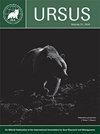Assimilated diet patterns of American black bears in the Sierra Nevada and western Great Basin, Nevada, USA
IF 0.6
4区 生物学
Q4 ZOOLOGY
引用次数: 5
Abstract
Abstract: In western Nevada, USA, the American black bear (Ursus americanus) coexists with humans and increasing urban sprawl. Hotels, casinos, restaurants, and homeowners dispose large quantities of high-protein, calorie-rich foods, often in unsecured waste containers. We used 173 hair samples from black bears captured in western Nevada from 2003 to 2010 and conducted δ13C and δ15N analysis to examine anthropogenic food use. We developed a set of a priori models to examine the effect of biological (sex, age class, mass category [considering sex and age]), chronological (season, molt phase, and year), and spatial (urban–wildland classification [UW class]) factors potentially affecting use of anthropogenic foods and accompanying stable isotope signatures. Bears in above-average mass categories had enriched 13C and 15N signatures compared with bears of below-average mass. Wildland bears had depleted 13C compared with urban bears and appeared to use human foods less. Postmolt hair samples (representing late-spring–early summer diet) were depleted in both 13C and 15N relative to premolt hairs (late-summer–autumn diet), indicating changes in food availability. Male black bears had enriched 15N compared with females, indicating more meat in their diet. Our results indicated substantial 13C and 15N enrichment of black bear diets in Nevada, which was affected by biological, chronological, and spatial factors. Using mixing models of the 2 isotopes, we found both urban and wildland bears relied on natural and anthropogenic foods, with wildland bears using wild foods more often. There was only 3.8% difference in the median use of human foods between urban and wildland bears, but great variability for individual bears in each location category. Our results affirmed that, to effectively address human–bear conflicts, officials should emphasize exclusion of anthropogenic food attractants on a year-round basis and further try to understand factors affecting individual bear use of garbage.美国内华达州内华达山脉和西部大盆地美国黑熊同化饮食模式
摘要:在美国内华达州西部,美国黑熊(Ursus americanus)与人类和日益扩张的城市共存。酒店、赌场、餐馆和房主处理大量高蛋白、高热量的食物,通常是在没有固定的废物容器中。本文利用2003年至2010年在内华达州西部捕获的173只黑熊毛发样本,进行了δ13C和δ15N分析,以研究人为食物使用。我们开发了一套先验模型来检验生物(性别、年龄、质量类别[考虑性别和年龄])、时间(季节、蜕皮期和年份)和空间(城市-荒地分类[UW类])因素对人类食物使用的潜在影响及其伴随的稳定同位素特征。与质量低于平均水平的熊相比,质量高于平均水平的熊具有丰富的13C和15N特征。与城市熊相比,野生熊已经耗尽了13C,而且似乎更少食用人类食物。相对于蜕皮前毛发(夏末-秋季饮食),蜕皮后毛发样本(代表晚春-初夏饮食)在13C和15N条件下都被消耗殆尽,这表明食物供应发生了变化。与雌性相比,雄性黑熊富含15N,这表明它们的饮食中有更多的肉。研究结果表明,内华达州黑熊的饮食中含有大量的13C和15N,这受到生物、时间和空间因素的影响。通过两种同位素的混合模型,我们发现城市熊和野生熊都依赖于自然和人为食物,野生熊更经常使用野生食物。城市熊和野生熊对人类食物的中位数使用只有3.8%的差异,但每个地点类别的熊个体差异很大。我们的研究结果证实,为了有效解决人熊冲突,官员们应该强调在全年的基础上排除人为食物引诱剂,并进一步尝试了解影响熊个体使用垃圾的因素。
本文章由计算机程序翻译,如有差异,请以英文原文为准。
求助全文
约1分钟内获得全文
求助全文
来源期刊

Ursus
生物-动物学
CiteScore
2.00
自引率
15.40%
发文量
12
审稿时长
>12 weeks
期刊介绍:
Ursus includes a variety of articles on all aspects of bear management and research worldwide. Original manuscripts are welcome. In addition to manuscripts reporting original research, submissions may be based on thoughtful review and synthesis of previously-reported information, innovative philosophies and opinions, and public policy or legal aspects of wildlife conservation. Notes of general interest are also welcome. Invited manuscripts will be clearly identified, but will still be subject to peer review. All manuscripts must be in English. All manuscripts are peer-reviewed, and subject to rigorous editorial standards.
 求助内容:
求助内容: 应助结果提醒方式:
应助结果提醒方式:


